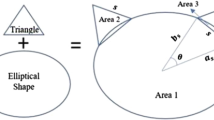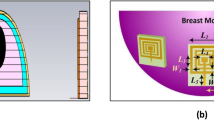Abstract
In this paper, two Sierpinski carpet UWB fractal antennas are designed and fabricated. The first fractal antenna is an antenna that has not any notch filter. The second one is an antenna with double notch filters. Antenna without notch filter has an operating band of (3.1–10.8) GHz with a gain of 5.3 dB at 10 GHz. This antenna has a low group delay variation. Antenna with double notch filters working at (3.36–12) GHz band shows a gain reduction and higher group delay at the filters operating band. Out of the notch filters operating band, the antenna has a low group delay variation and a gain near to the gain of the antenna without notch filters. The MIMO version of the antenna shows an operating band up to 10.8 GHz and isolation between ports higher than 15 dB.
















Similar content being viewed by others
References
Federal Communications Commission revision of Part 15 of the commission’s rules regarding ultra-wideband transmission systems. (2002). FCC, Washington, DC, First Report and Order FCC, 02. V 48.
Zhang, J. P., Xu, Y. S., & Wang, W. D. (2008). Microtrip-fed semi-elliptical dipole antennas for ultrawideband communications. IEEE Transactions on Antennas and Propagation, 56(1), 241–244.
Li, W. T., Shi, X. W., & Hei, Y. Q. (2009). Novel planar UWB monopole antenna with triple band notched characteristics. IEEE Antennas and Wireless Propagation Letters, 8, 1094–1098.
Li, X., Yang, L., Gong, S.-X., & Yang, Y.-J. (2009). Ultra-wideband monopole antenna with four-band-notched characteristics. Progress in Electromagnetics Research Letters, 6, 27–34.
Li, J., Liu, Y. S., & Luo, S. Q. (2014). Four-band-notched UWB antenna using three circular split-rings and a square split-ring. In 2014 IEEE international conference on communication problem-solving (ICCP).
Wang, A., Zhenghe, F., & Luk, K.-M. (2009). Pattern and polarization diversity antenna with high isolation for portable wireless devices. IEEE Antennas and Wireless Propagation Letters, 8, 209–211.
Sharma, M., Awasthi, Y. K., Singh, H., Kumar, R., & Kumari, S. (2016). Compact printed high rejection triple band-notch UWB antenna with multiple wireless applications. An International Journal Engineering Science and Technology, 19, 1626–1634.
Bakariya, P. S., Dwari, S., & Sarkar, M. (2015). Triple band notch UWB printed monopole antenna with enhanced bandwidth. AEU—International Journal of Electronics and Communications, 69, 26–30.
Fallahi, H., & Atlasbaf, Z. (2015). Bandwidth enhancement of a CPW-fed monopole antenna with small fractal elements. AEU—International Journal of Electronics and Communications, 69, 590–595.
Yeganeh, A. N., Najmolhoda, S. H., Sedighyc, S. H., & Ali-Nezhadd, S. M. (2018). Design of a compact planar wide band antenna family. AEU—International Journal of Electronics and Communications, 83, 280–287.
Mewaraab, H. S., Mahendra, D. J., Jitendra, & Deegwala, K. (2018). A printed monopole ellipzoidal UWB antenna with four band rejection characteristic. AEU—International Journal of Electronics and Communications, 83, 222–232.
Heydari, S., Pedram, K., Ahmed, Z., & Zarrabi, F. B. (2017). Dual band monopole antenna based on metamaterial structure with narrowband and UWB resonances with reconfigurable quality. AEU—International Journal of Electronics and Communications, 81, 92–98.
Bing, Y., & Qu, S. (2017). A compact integrated Bluetooth UWB dualband notch antenna for automotive communications. AEU—International Journal of Electronics and Communications, 80, 104–113.
Ajay, Y., Agrawal, S., & Yadav, R. P. (2017). SRR and S-shape slot loaded triple band notched UWB antenna. AEU—International Journal of Electronics and Communications, 79, 192–198.
Zarrabi, F. B., Mansouri, Z., Gandji, Navid P., & Kuhestani, H. (2016). Triple-notch UWB monopole antenna with fractal Koch and T-shaped stub. AEU—International Journal of Electronics and Communications, 70, 64–69.
Mohandoss, Susila, Thipparaju, Rama Rao, Reddy, Bobbili Naga Balarami, Palaniswamy, Sandeep Kumar, & Marudappa, Pushpalatha. (2018). Fractal based ultra-wideband antenna development for wireless personal area communication applications. AEU—International Journal of Electronics and Communications, 93, 95–102.
Avula, R., Rangarao, M., & Kumari, Y. (2019). Fractal ultra wide band antenna for 5G applications. International Journal of Recent Technology and Engineering, 7(5), 215–218.
Tirado-Mendez, J. A., Martinez-Lara, D., Jardon-Aguilar, H., Flores-Leal, R., & Andrade-Gonzalez, E. A. (2019). Inscribed Fibonacci circle fractal in a circular radiator for ultra-wideband antenna operation and size reduction. International Journal of Antennas and Propagation, 2019, 6393401.
Manohar Kumar, Ch., & Kumar Muvvala, N. V. S. S. (2019). A compact ultra-wide band rhombus shaped fractal antenna with metamaterial in the ground plane. International Journal of Engineering and Advanced Technology, 8(6), 1349–1354.
Ramamurthy, V., & Govindarajan, Y. (2019). High gain ultra wideband fractal antenna. Journal of Computational and Theoretical Nanoscience, 16(4), 1597–1601.
Liu, G., Gu, J., Gao, Z., & Xu, M. (2019). Wideband printed slot antenna using Koch fractal metasurface structure. International Journal of RF and Microwave Computer-Aided Engineering. https://doi.org/10.1002/mmce.22058.
Ahmed, B. T., Olivares, P. S., Campos, J. L. M., & Vázquez, F. M. (2018). (3.1–20) GHz MIMO antennas. AEU—International Journal of Electronics and Communications, 94, 348–358.
Author information
Authors and Affiliations
Corresponding author
Additional information
Publisher's Note
Springer Nature remains neutral with regard to jurisdictional claims in published maps and institutional affiliations.
Appendix
Appendix
Figure 15 shows the Sierpinski carpet with rectangle recursion at different iterations.
Figure 16 shows the Sierpinski carpet with rectangle recursion at fourth iteration. This shape is used to construct the radiating element of the antenna.
Figure 17 shows the fabricated MIMO antenna without notch filters. The antenna consists of two radiating elements with a metallic barrier between them. This barrier is used to increase the isolation between the two radiating elements. The metallic barrier has a length of 20 mm and a width of 1.25 mm. Separation between the radiating elements is 10 mm.
Figure 18 shows a comparison between the simulated and measured S11 of the MIMO antenna. It can be noticed that the fabricated antenna works well within the band (2.9–10.8) GHz, i.e., it has S11 lower than − 10 dB in the above mentioned band.
Figure 19 shows a comparison between the simulated and measured S21 of the MIMO antenna. It can be noticed that the fabricated antenna works well (with an isolation higher than 15 dB) within the band (2.5–15.0) GHz.
The Envelope Correlation Coefficient of the MIMO antenna is given by:
In the band (3.1–10.6) GHz, the Envelope Correlation Coefficient (ECC) is lower than 0.02 and the diversity gain is higher than 9.9 dB.
Rights and permissions
About this article
Cite this article
Ahmed, B.T., Hernández, D.B. UWB Fractal Antennas with Low Group Delay Variation. Wireless Pers Commun 114, 1999–2016 (2020). https://doi.org/10.1007/s11277-020-07459-z
Published:
Issue Date:
DOI: https://doi.org/10.1007/s11277-020-07459-z









